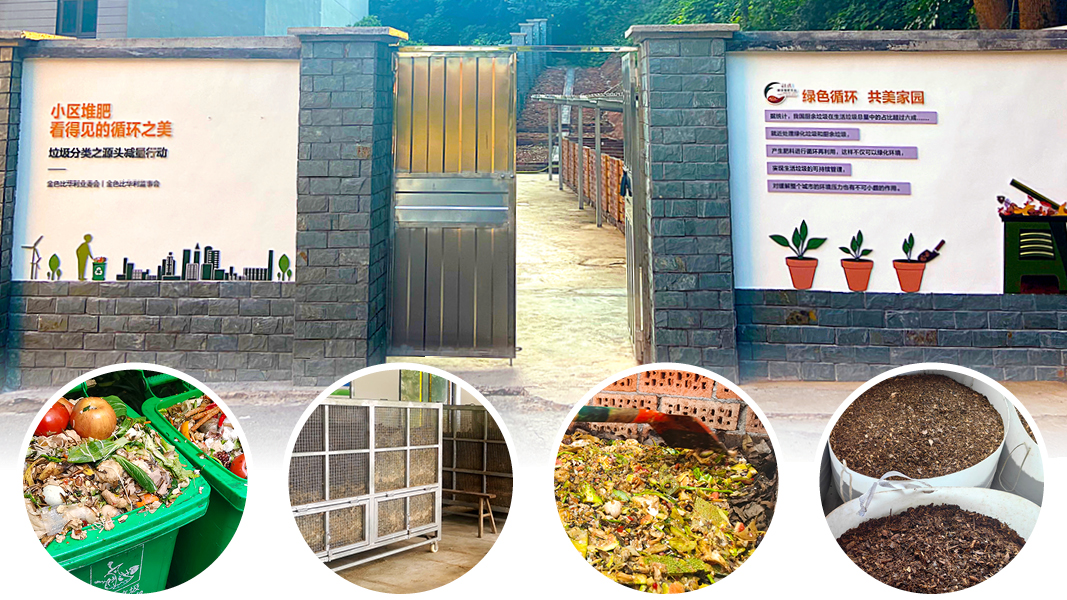Top: Entranceway into the composting facility at Bihuali apartment complex in Changsha, Hunan Province. All photos in article courtesy of the China Community Composting Program.
Xuehua Zhang
China has a long history of composting in its agriculture sector. Farmers composted animal waste together with human waste and agricultural residuals then applied the finished compost to soil for producing food. In recent years, as disposal of solid waste has increasingly become a major problem in China, some cities and counties started building centralized, large-scale municipal composting facilities, mostly for handling biosolids and manures. In the 1990s, there were initiatives to use composting to recycle urban food waste, but those failed primarily due to unseparated food waste that contaminated the quality of the finished compost. No evidence exists of meaningful on-site composting of food waste in urban communities before 2017, although source separation of food waste was tried in various places but never really succeeded. The general perception was that composting could not take place in a highly populated urban community in China and it would likely encounter public resistance. What is also true is the dislike of composting in rural residential areas where semi-urbanization has taken place.
I first learned about decentralized, community-scale composting of organic waste in 2015 in Bengaluru, India. The city government had issued a mandate in 2013 requiring source separation of solid waste by all generators and on-site composting of separated food waste by all bulk generators (e.g., residential complexes with more than 50 households or commercial entities generating 100kg (220 lbs) of garbage daily). As 60% of over 10 million residents in Bengaluru living in gated apartment complexes represent a very similar modern urban lifestyle one finds in China, Bengaluru’s experience with on-site composting of food waste serves as an invaluable model. The common challenges (such as odor, flies and leachate concerns) that Bengaluru communities had to overcome are nearly identical to those of Chinese communities. A research team was assembled and we conducted an in-depth empirical study of the Bengaluru model in 2016-2017 to assess if the knowledge, experience and lessons learned from this study could work in China.
Pilot Program Design
The Lishui Institute of Ecology and Environment (my employer), jointly with the Vanke Foundation providing financial support, launched a national experimental community composting program in China in December 2018. Two primary goals were incorporated into the program design: 1) Examine whether on-site composting could work in Chinese communities; and 2) Explore whether community composting could be a technical solution for recycling food waste locally. Three key criteria for defining composting as a technical solution for the communities were identified: Acceptance by the affected residents; daily processing of a substantial amount of food waste (at least 100kg/day (220 lbs) as initially expected) or of a full amount of separated food waste; and quality of matured compost.
A project team was established to provide technical and managerial support for the communities selected for the program, which has involved two phases — the first focusing on the first goal and the second targeting the second goal. No financial support was provided for those involved in the first phase (2019). For the second phase (March 2021-December 2022), approximately $7,000 was given to each of the eight participating communities and roughly $20,000 was given to each of two composting promotion centers. The funding could be used to cover composters or materials for making composters, tools, bulking materials if needed, and labor. An online data reporting system was created for participants to submit their daily composting data including weight of feedstock, temperature of composting piles, moisture level, and potential problems such as odor, leachate and flies. A set of key parameters and standards for testing the quality of finished compost was established.
Through nearly five years of experiments, approximately 50 urban and rural communities located in 22 provinces throughout China have participated in the program. Nearly half have continued composting on-site as of today, while many stopped composting in a given community after the project ended, but started composting in another community. The entity in charge of each composting site varies, e.g., they include a nongovernmental organization (NGO) working on waste issues or community building, community volunteers, homeowners’ committees, government residents/village committees, college teachers, and college student groups. With best management practices, nearly all the composting sites have become acceptable and welcomed by residents. Most of the compost samples tested met established safety requirements and contain rich nutrients and microbes.
The experiments demonstrate that continuous composting, i.e., adding a substantial amount of food waste daily (in practice at least 30kg (66 lbs)/day), proves to be much more challenging than the periodic addition (such as weekly or monthly) of food waste to the composters. These operations require sufficient space, supply of well-sorted food waste and locally available bulking materials, as well as designated composting personnel and funding to sustain the operations.
Case Studies
Two project examples are a rural village that managed to separate and locally compost all its food waste and a large urban residential complex that succeeded in composting 100kg of food waste nearly on a daily basis. Both projects were established and managed during the COVID pandemic period where restrictions were most stringent, e.g., periods when residents were not allowed to leave home or all community resources were devoted to daily COVID testing.
Case Study 1: Rural Village
Jianling Village, with roughly 1,500 officially registered villagers (with about 300 living there year-round), was the only pilot project to compost all the separated food waste generated from residents. It is located in a relatively remote rural area in Zhejiang Province, a developed coastal region in China. About 23% of the villagers are over 60 years old, a typical aging community. Before 2018, the township government collected household garbage (mixed) and transported it to the county landfill for disposal.
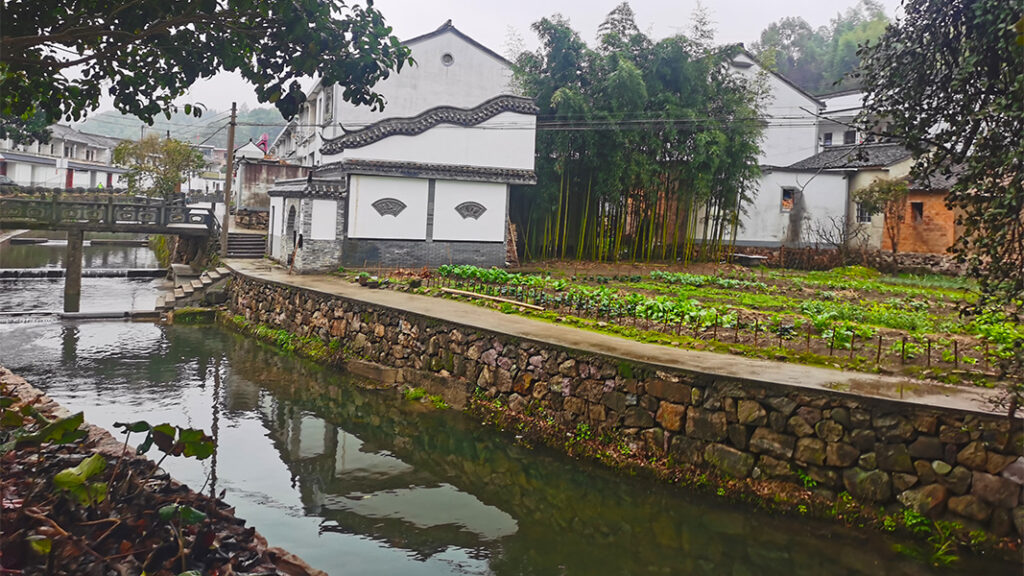
Jianling Village, with over 1,500 registered villagers, is in a relatively remote rural area in Zhejiang Province, a developed coastal region in China.
A locally born environmentalist who built her career in the city returned to the village in 2018. With the township government’s support, she started promoting waste separation among the villagers. An NGO was established and many villagers have become volunteers. Within a year, nearly all villagers started separating their household waste into dry recyclables, kitchen waste and non-recyclables. The initial composting method used precooked fruit and vegetable waste from households making fermented fruit and vegetable juice (commonly known as Jiaosu). A switch was made to mix all kitchen waste (precooked and cooked) with soil in cement tanks — a very slow decomposition process that often generated bad smells, lots of flies and awful leachate. This raised complaints from some villagers. Moreover, the application of the final product to soil did not seem to make a difference in plant growth.
Starting in June 2021, the village joined our national community composting program for financial and technical support to improve its composting facility, methods, and management. The composting site (roughly 200 square meters or about 2,200 sq. ft.) was upgraded; two large bins made of stainless mesh (3.6 cubic meters each (127 ft3)) were installed for active composting and two wooden bins (1.73 cubic meters each (60 ft3)) were built for maturation. The villagers in charge of composting collected dry leaves, straw, crushed tree branches and bamboo sawdust as bulking materials. Some villagers still keep some precooked kitchen waste, mostly fruit residuals, for making Jiaosu, however the majority of separated kitchen waste is used for active composting. A member of the local NGO was designated as the composting manager. Each day, as waste collection is completed, the manager and two waste collectors (all local villagers) weigh and add separated kitchen waste and bulking materials layer by layer into the stainless bin. Mixing the feedstocks before adding them to the bin was tried, but too much time and labor were required. The layer method was found to work effectively. The pile is sprayed with Jiaosu on occasion, then covered with bulking materials or matured compost. The composting manager conducts routine monitoring, e.g., checking temperature, moisture level and other parameters to ensure conditions are optimal.
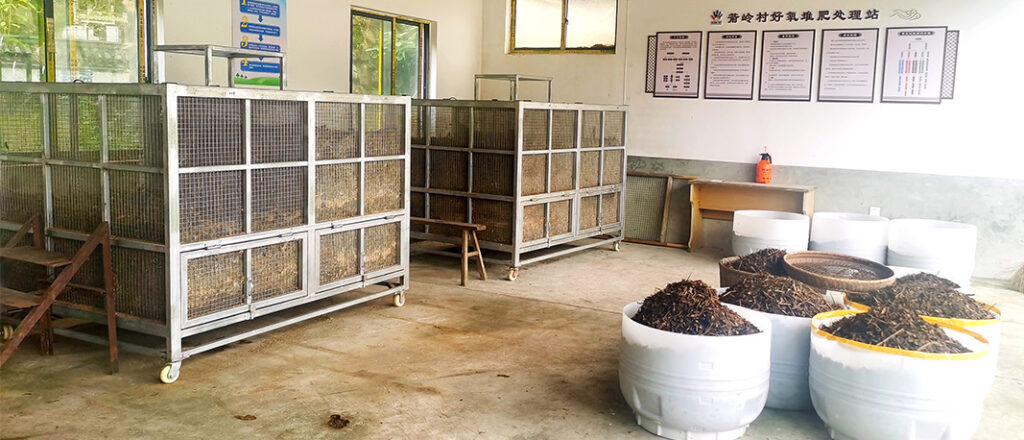
Two large bins made of stainless mesh (each 3.6 cubic meters) were installed for active composting in Jianling Village.
The ratio of bulking materials to kitchen waste is approximately 1.5:1 in volume. It takes about two to three hours to complete the daily processing. Additional tasks include periodically collecting and preparing bulking materials, screening and storing matured compost, and compost application. The composting manager is paid about $8.20/day (60 RMB), which was covered by our program during the project period. Since then, the township government has subsidized this labor cost.
From June 2021 to June 2022, a total of 12.26 tons of kitchen waste and 3.28 tons of bulking materials were processed, ranging from 30 to 60kg/day (66-132 lbs) and occasionally >80kg (>175 lbs). Typically, it took 10 to 15 days to fill up half of a stainless composter (each has two compartments); by the time both stainless composters were full, feedstock in the first half had been there for at least 50 days and could be transferred to a wooden composter for maturation. Pile temperature usually rose to 60°C on the fourth day after starting to add kitchen waste; that temperature could be maintained up to 50 days during summer and at least 10 days during winter — sufficient to kill pathogen and weeds. No turning is necessary during the process. It generally takes about 80 days to complete a composting cycle, with matured compost ready for use. Finished compost is well received among the villagers and has been used for local farming. The Jianling community composting operation has become sustainable and the township government is considering promoting it to other villages under its jurisdiction.
Case Study 2: Urban Residential Complex
Bihuali is a typical large mid-rise urban apartment complex located in Changsha, capital of Hunan Province in the central region of China. It has 22 buildings with 1,820 households; among them, 80% are permanent residents. Unlike many other urban apartment complexes, Bihuali does not have a property management company. Instead, it has a strong, self-governing homeowners committee selected by the owners; the committee in turn directly hires a property manager and maintenance staff. For all major issues, the owners committee makes the decisions. The property manager directs maintenance staff to carry out the tasks.
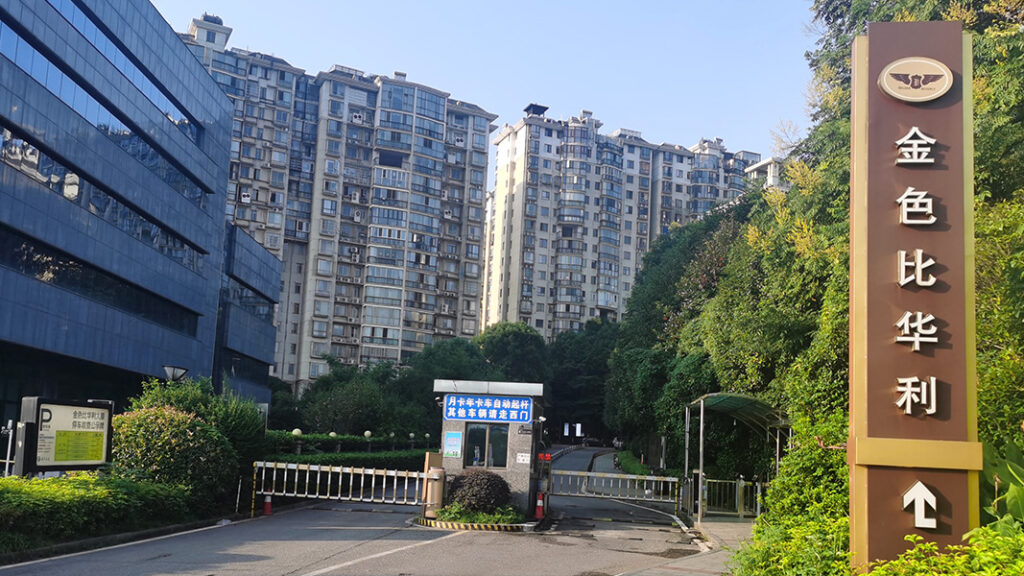
Bihuali apartment complex in Changsha, the capital of Hunan Province. There are 1,820 households in the complex.
In October 2020, the city government decided to require source separation of food waste throughout the city. The owners committee followed the order by actively mobilizing residents to engage in sorting out their waste into dry recyclables, kitchen waste and non-recyclables. As everywhere else in the world, it takes a long time for people to cultivate waste separation behavior. Not surprisingly, our field investigation in 2021 revealed that not many residents actually separated their waste at home; most food waste was sorted and collected by the complex’s cleaning staff after going through mixed garbage bins in order to meet the government requirements. Although time and labor consuming, the secondary separation did provide a substantial amount of high quality food waste for composting when joining our program. Unfortunately, the city government followed the national requirements for initiating the garbage separation, but it has not established capacity for recycling sorted food waste. The majority of separated waste streams end up being incinerated. Garden waste is primarily landfilled.
Bihuali’s primary objectives of implementing a community composting approach are to recycle organic waste locally and apply compost to improve the poor soil that was not suitable for growing flowers. About 50% of the complex is covered with grass and trees, generating a large amount of garden waste to use as bulking material for composting the kitchen waste. The composting site is located inside the complex and right next to the gate making it very visible and convenient to residents walking by. To process at least 100kg (220 lbs) of kitchen waste daily, the complex built 12 composting bins made of hollow bricks, each about 1.7 cubic meters (60 ft3). The bins are divided into three sets of four, with composting initiated with one set at a time.
Every morning, the designated composting manager and his assistant bring the separated food waste (often sorted by cleaning staff) to the composting site. They do another round of separation to ensure the purity of feedstock. Incoming kitchen and garden waste are weighed and then evenly divided into four portions and added in layer by layer (kitchen and garden waste respectively) into each bin. The ratio of kitchen waste to garden waste in mass varies, usually 2:1 when garden waste is fresh and 3:1 when it is drier or contains more dry leaves. A total of 100 to 120kg (220-265 lbs) of kitchen waste is processed daily. Once feedstock processing is completed for the day, the team covers the pile in each bin with a thin layer of matured compost. The composting manager then conducts routine monitoring of piles, e.g., checking temperature, moisture level and other parameters to ensure each pile is in good condition. Finally, the site and tools are cleaned and garden waste is collected and crushed for the next day. It usually takes 12 to 18 days to fill up a set of bins. Once filled, another set of bins begin to be filled while the full bins are left to continue decomposing until the contents are mature. A full composting cycle from adding feedstock to mature compost for use is about 60 to 80 days.

The ratio of garden waste (top) to kitchen waste (bottom) in mass varies, usually 2:1 when garden waste is fresh and 3:1 when it is drier or contains more dry leaves.
From June 2021 to June 2022, approximately 26 tons of organic waste (17.21 tons of kitchen waste and 8.89 tons of garden waste) were processed. The matured compost after testing meets the standards and was safely applied to the community soil. Residents began observing the benefits of using compost in the fall of 2021 when the planted flowers survived and bloomed beautifully, in part because the soil was holding more plant available water. These changes caught residents’ attention; many requested mature compost for their balcony plants and flowers. Composting has become increasingly popular within the complex and piques interest from visitors from residential complexes elsewhere in the city.
Importantly, Bihuali’s owners committee managed to adjust additional workloads caused by on-site composting so the composting team is available to do other property management work. As a result, the composting project did not incur additional labor cost to the complex. When the funding cycle for Bihuali ended in July 2022, the established composting routine was able to continue. The beauty of the garden beds and the popularity of the compost has led the owners committee to consider plans for scaling up the operation later in 2023.
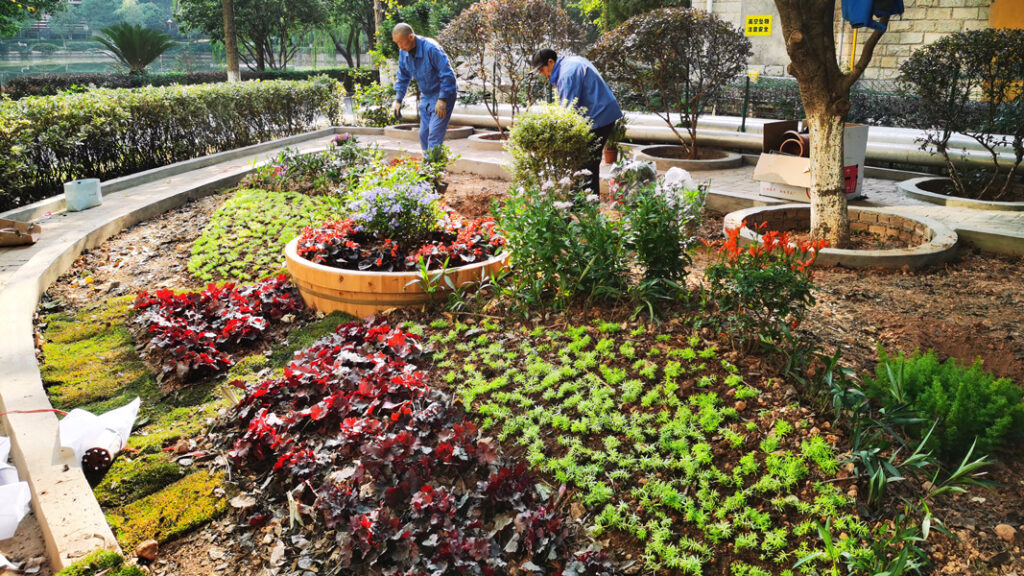
Residents began observing the benefits of using compost in the fall of 2021 when the planted flowers survived and bloomed beautifully.
Our national community composting program demonstrates that, with best management practices and when the conditions permit, a community can recycle all its separated food waste mixed with garden waste on-site on a daily basis and safely apply the compost locally to its gardens and farms. People in both rural and urban areas appear to accept composting within their residential communities. This is particularly important when centralized composting facilities do not exist in most areas of China. Key to scaling up the community composting approach is having officially established quality control standards for the finished compost that boosts public acceptance and confidence. Government policy and financial support will help many communities jump-start community-scale composting.
Dr. Xuehua Zhang is Senior Researcher at Lishui Institute of Ecology and Environment and the founder of the China Community Composting Program (CCCP). She holds a PhD in Environmental Policy from Stanford University. Areas of research interests are organic waste management, environmental and climate policy, environmental compliance and enforcement. The CCCP’s management team members are Shiwen Zhang, Qian Liu, Xiaxia Wang, Yimin Yao and Dabao Li.


